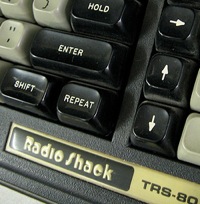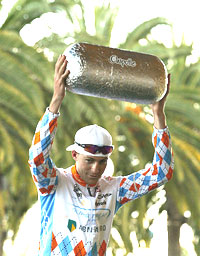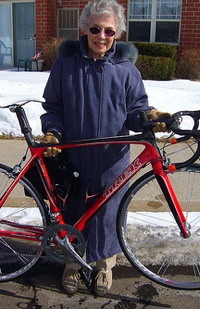 When Bonnie Ford leaked news of Lance Armstrong’s new sponsor, many an eyebrow was raised. Radio Shack? It would be like Manchester United getting sponsored by Poundstrecher, noted one British commentator; it just doesn’t make sense.
When Bonnie Ford leaked news of Lance Armstrong’s new sponsor, many an eyebrow was raised. Radio Shack? It would be like Manchester United getting sponsored by Poundstrecher, noted one British commentator; it just doesn’t make sense.
After all, a surprisingly large number of pixels has been scattered on the notion that cycling is the new golf. Rapha Condor, their stylish wardrobe notwithstanding, is largely irrelevant as far as international cycling teams go— yet they’ve just managed to add a bundle of new, higher-end sponsors, including Sharp Electonics and Malmaison hotels.
Cyclists, conventional wisdom seems to be, are well-heeled consumers who are willing, and indeed want to pay for the total package. Years of purchasing things in gruppos has conditioned them to go to Best Buy and get the whole entertainment center. So long as the Geek Squad takes care of all the dirty work, and they’ve got a nice system to show off to the neighbors, who cares if the HDMI cables cost six times as much?
But the cyclists I know—”real cyclists”, to adulterate a notion of the erstwhile Alaska governor—are scrappy Cat 4s, 3s, and 2s with weekly incomes roughly equivalent to their watts at threshold. These are the sort of people who can scarcely afford the buy-it-all approach of a Best Buy—or a Competitive Cyclist, for that matter—and resent the attempts of retailers to force it on them.
Oh, sure, these cyclists love doing business online, but it’s not the full-service, total package variety. It’s three-moths-worth of long-overdue gear crammed onto someone else’s Performance Bike account to save on shipping charges—or would be, if not for the local shops feeding them parts at employee or team purchase prices.
 And this is where Radio Shack comes in. Who among you—other than Ryan Kelly—can say that your Chipotle intake hasn’t increased dramatically since their association with Slipstream in 2007? Lance’s previous team sponsors were clearly not looking for consumer dollars; for personal mail, USPS has been dominant for years, and in most cases, Discovery Channel is free with your monthly cable payment, whether you choose to watch Shark Week or not.
And this is where Radio Shack comes in. Who among you—other than Ryan Kelly—can say that your Chipotle intake hasn’t increased dramatically since their association with Slipstream in 2007? Lance’s previous team sponsors were clearly not looking for consumer dollars; for personal mail, USPS has been dominant for years, and in most cases, Discovery Channel is free with your monthly cable payment, whether you choose to watch Shark Week or not.
Radio Shack, on the other hand, has done quite well for itself recently by appealling to the cheap, smart, scrappy DIYer; the sort of person who can’t look at a Best Buy price tag without scoffing, and who’d be more than willing to jack down a limit screw and ride single-speed for a week, if it means undercutting retail cost on a new derailleur.
Sponsoring a cycling team puts Radio Shack—and its store full of thrifty electronic workarounds—front and center in the ever-spinning, cost-saving minds of citizen racers. Sure, they can still get a six-foot stereo cable (to hook their AirPort to the beat-up stereo they just bought off Craigslist) for three dollars less online. But after this sponsorship announcement, buying at Radio Shack—where they don’t have to wait or pay for shipping—just acquired an additional level of appeal.
And once cyclists get in the door, they’re that much closer to buying a power inverter to power/charge laptops on their way to and from races, and maybe even getting an s-video to RCA adaptor to watch the Vuelta in full-screen on their crummy old TVs. Tech-savvy has been a de facto requirement to enjoy cycling in this country for some time; Radio Shack might just be the first company to successfully monetize that.
 Lastly, the Armstrong/Radio Shack association is mutually beneficial. In case you’ve never read the comments section on this blog, serious American cyclists tend not to be Lance Armstrong’s most fervent supporters.
Lastly, the Armstrong/Radio Shack association is mutually beneficial. In case you’ve never read the comments section on this blog, serious American cyclists tend not to be Lance Armstrong’s most fervent supporters.
Seeing the seven-time Tour winner as a billboard for practical, even clever solutions—instead of the inspiration for hairy-legged guys on SRAM Red-equipped Madones that let gaps open on fast group rides—can only improve his standing in the eyes of most cyclists I know.
So surprising? Yes. Radio Shack certainly doesn’t fit the high-gloss legacy left by Thomas Weisel Partners, nor the now-generally-accepted image of cycling in America as a sport of elites. But times have changed dramatically since 1999, and everyone, even Lance Armstrong, has had to adapt.
Without knowing the budget history of RadioShacks’ marketing department or details of the money RS has committed to the team, I’m going out on a limb by saying it looks like many American-sponsored teams in recent decades.
7-Eleven, Coors Light, Crest (remember Alexi Grewal?), Subaru-Montgomery (same team as USPS if I’m not mistaken) and Wheaties (cereal) don’t exactly scream elitism.
P.S. I’m confident that our gut perception of RS will be better in one year’s time than it is now, despite our feelings towards Mr. Passive-Aggressive Vindictive God-King Deity Guy.
Radio Shack, “tune in, turn on, drop out.”
I’ll be setting my FM radio off channel to static, wait for the signal spikes, and watch the meteorites drop out of the sky! (amateur astronomers trick).
Watching highly paid team ponce around the world whilst the workers make small bikies (and the business is struggling, re: USPS), is normally not your normal best business plan. But hey sit back and enjoy, a la T Leary.
“Who among you—other than Ryan Kelly—can say that your Chipotle intake hasn’t increased dramatically since their association with Slipstream in 2007?”
Not me. But I can’t say I disagree totally. I went and ordered one of those ugly catlike helmets Cervelo TT was wearing knowing in my heart of hearts, they are aesthetically challenged. But who cares when Thor the sprinter was out conquering mountains solo in an effort to secure green all the while donning the honeycomb helmet. But in my defense, I will never buy a Trek bike. Do I need to state why??? I guess transistors at RS to repair my Commodore 64 are out too…
Interesting point, Josh. Not sure about Subaru—their SUV is called the Tribeca—but you’re right: the other brands are definitely aimed more at the Cutters. (Though you could argue that Pete Coors’ ultra-capitalist agitating disqualifies the Coors Light squad).
However, I think Radio Shack’s nerd appeal sets it apart a bit from the other consumer-focused sponsors.
They also sponsor a NASCAR team
Pete Coors? You mean fascist, right? 😉
Touche` re: Subaru; but don’t forget how non-upscale it was back then. I think the Legacy was the high-end model in the mid-1990s.
Saw your Twitter link re: Fignon and Herrera in 1987. How bizarre (sloppy?) is it that the Tour in question isn’t specified until halfway through the article? It was the Vuelta not the TdF.